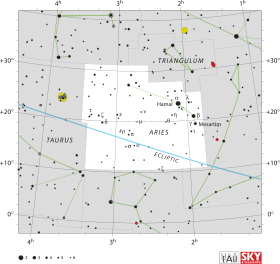HD 15524 , également désignée HR 728 , est une étoile binaire [ 3] constellation du Bélier . D'après la mesure de sa parallaxe annuelle par le satellite Hipparcos , le système est situé à environ 169 années-lumière parsecs Terre [ 1]
Sa composant primaire, désignée HD 15524 A , est une étoile jaune-blanc sous-géante de type spectral F6 IV [ 4] séquence principale de type F4 V [ 4] magnitude apparente est de 5,94, ce qui signifie qu'elle peut être observée à l'œil nu dans de bonnes conditions. La composante secondaire, HD 15524 B , est séparée de la composante primaire par 12,4 secondes d'arc [ 3]
Le système est la source probable d'émissions de rayons X provenant de ces coordonnées[ 11]
↑ a b c d e et f (en) F. van Leeuwen, « Validation of the new Hipparcos reduction », Astronomy & Astrophysics vol. 474, no 2, 2007 , p. 653–664 (DOI 10.1051/0004-6361:20078357 Bibcode 2007A&A...474..653V arXiv 0708.1752 S2CID 18759600 ↑ a et b (en) HD 15524 -- High Proper Motion Star sur la base de données Simbad Centre de données astronomiques de Strasbourg .↑ a b et c (en) P. P. Eggleton et A. A. Tokovinin, « A catalogue of multiplicity among bright stellar systems », Monthly Notices of the Royal Astronomical Society vol. 389, no 2, 2008 , p. 869 (DOI 10.1111/j.1365-2966.2008.13596.x Bibcode 2008MNRAS.389..869E arXiv 0806.2878 S2CID 14878976 ↑ a b et c (en) E. A. Harlan, « Mk classifications for F and G-type stars », The Astronomical Journal vol. 74, septembre 1969 , p. 916 (DOI 10.1086/110881 Bibcode 1969AJ.....74..916H ↑ (en) H. A. Abt, « Visual multiples. VIII - 1000 MK types », The Astronomical Journal Supplement Series vol. 59, 1985 , p. 95 (DOI 10.1086/191064 Bibcode 1985ApJS...59...95A ↑ a b et c (en) Matthias Ammler-von Eiff et Ansgar Reiners, « New measurements of rotation and differential rotation in A-F stars: are there two populations of differentially rotating stars? », Astronomy & Astrophysics vol. 542, juin 2012 , article no A116 (DOI 10.1051/0004-6361/201118724 Bibcode 2012A&A...542A.116A arXiv 1204.2459 S2CID 53666672 ↑ (en) G. A. Gontcharov, « Pulkovo Compilation of Radial Velocities for 35 495 Hipparcos stars in a common system », Astronomy Letters vol. 32, no 11, novembre 2006 , p. 759–771 (DOI 10.1134/S1063773706110065 Bibcode 2006AstL...32..759G arXiv 1606.08053 S2CID 53666672 ↑ a b c et d (en) Trevor J. David et Lynne A. Hillenbrand, « The Ages of Early-Type Stars: Strömgren Photometric Methods Calibrated, Validated, Tested, and Applied to Hosts and Prospective Hosts of Directly Imaged Exoplanets », The Astronomical Journal vol. 804, no 2, 2015 , p. 146 (DOI 10.1088/0004-637X/804/2/146 Bibcode 2015ApJ...804..146D arXiv 1501.03154 S2CID 33401607 ↑ (en) E. Anderson et Ch. Francis, « XHIP: An extended hipparcos compilation », Astronomy Letters vol. 38, no 5, 2012 , p. 331 (DOI 10.1134/S1063773712050015 Bibcode 2012AstL...38..331A arXiv 1108.4971 S2CID 119257644 ↑ (en) I. Ramírez et al. Lithium Abundances in nearby FGK Dwarf and Subgiant Stars: Internal Destruction, Galactic Chemical Evolution, and Exoplanets », The Astronomical Journal vol. 756, no 1, septembre 2012 , p. 46 (DOI 10.1088/0004-637X/756/1/46 Bibcode 2012ApJ...756...46R arXiv 1207.0499 S2CID 119199829 ↑ (en) Christian Bernt Haakonsen et Robert E. Rutledge, « XID II: Statistical Cross-Association of ROSAT Bright Source Catalog X-ray Sources with 2MASS Point Source Catalog Near-Infrared Sources », The Astronomical Journal Supplement vol. 184, no 1, septembre 2009 , p. 138–151 (DOI 10.1088/0067-0049/184/1/138 Bibcode 2009ApJS..184..138H arXiv 0910.3229 S2CID 119267456
Liens externes
